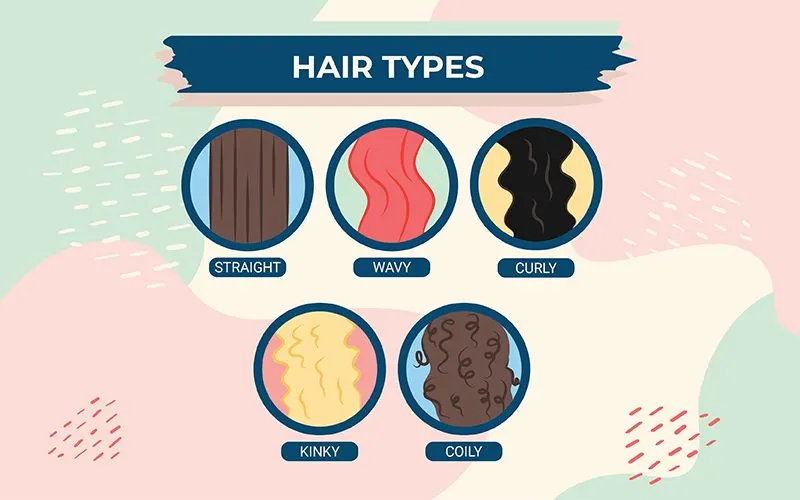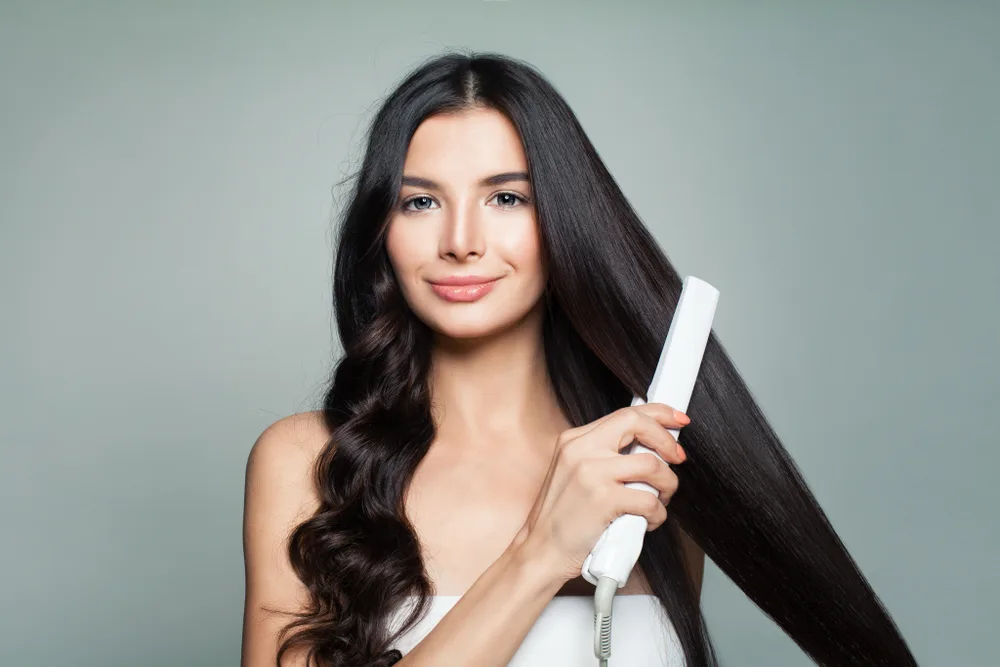Jump to:
Heating tools such as flat irons have become increasingly popular over the years. One question most flat iron users ask is what the hair straightening temperature should be. But don’t worry — we’ve rounded up everything you should know below.
The Best Hair Straightening Temperature
While a flat iron may finish your look, one thing to be cautious of is the fact that high temperatures can cause hair weak hair that becomes more prone to damage. But it’s not a one-temperature-fits-all solution.
Getting the heat setting for your hair is complicated and depends on several factors, such as your hair type, hair strength, how long and thick your hair is, and the hair straightener you use.
Even if you think it’s best to use a low-temperature setting when straightening your hair, this might not work for you. Your hair may require a higher temperature, and going with a higher temperature could damage your ends and cause the opposite look of the straight, frizz-free look you were trying to achieve.
We’ll cover all the details related to the hair straightening temperature you should be setting your flat iron to for certain types of hair. Let’s get started with the recommended heat settings.
You Might Also Like:
What Temperature Should Hair Straighteners Be?
It’s important to understand that the heat settings vary depending on your hair type, and it’s always best to start with the lowest setting and work up to higher settings as needed.
While we always suggest starting on low heat and working your way up, here are our recommendations for all hair types (again, always start low and work your way up to these):
| Hair Type | Temperature |
|---|---|
| Curly Hair | Up to 400 degrees |
| Bleached or Colored Hair | 300-350 degrees |
| Fine Hair | 250-300 degrees |
| Straight Hair | 300 degrees |
| Normal and Healthy Hair | 300-350 degrees |
There are a few other things you should know before straightening your hair with heat:
- Be sure to wash your hands
- You are able to use shampoos and conditioners on your hair before applying the heat
- You can use a heat protectant on your hair prior to beginning the straightening process
Hair Type

It’s probably no secret that certain hair types are easier to straighten with heating tools than others. For example, thick, curly hair will require a higher heat setting than fine, straight hair, requiring a much lower temperature.
Curly Hair
When you want to straighten your curly hair but want to do so without damaging your hair, it is crucial to pick the best heat setting for the job. Straightening curly hair is more of an effort than naturally straight hair.
Plus, it requires extra care and possibly higher temperature settings. Curls that are thick and coarse tend to be more prone to breakage and damage since they are naturally dry when applying heat to the curls.
You may want to make sure to apply a quality heat protectant spray prior to working with the heating tools.
You can use your hair straightener up to 400 degrees for long and thick curly hair to achieve the straight hairstyle you want.
If you’ve worked through your head of hair and aren’t happy with the results, try to increase the heat just a bit to see if you can achieve a better result with another pass.
Read Next: Does Heat Protectant Spray Really Work?
Bleached or Colored Hair
When you have bleached hair, your hair is potentially already compromised into a weak state, as bleaching weakens your hair’s natural strength and can cause damage to the hair.
You want to use extra caution when selecting a heat setting for your bleached hair so as not to cause any additional damage, but you do not want to risk your color fading away.
Try using your hair straightener between 300 and 350 degrees.
You can adjust the temperature as needed. If you feel any burning sensation between 300 and 350 degrees, you want to turn down the heat setting immediately.
Fine Hair
Fine hair isn’t exempt from hair damage. In fact, fine hair is more prone to heat damage. When using a hair straightening tool on fine hair, it is best to avoid any hair pieces that are already straight. You only want to focus on the piece of hair with a curl or wave shape.
When selecting the heat setting for fine hair, it is recommended that you use a heat setting of around 250-300 to protect your hair.
As always, the specific heat setting depends on the exact hair type, but this is a good starting point, and you can adjust the heat up or down as needed.
Straight Hair
If you have naturally straight hair and want to smooth out your hair or perhaps add a little flip at the ends, using a flat iron setting of around 300 degrees should be good for your hair.
Of course, you can go a little lower or higher depending on how 300 degrees work for your hair, but try to stay around this temperature.
When using this temperature, it should be less effort for you, meaning fewer passes with the hair straightener, therefore, less potential damage to your hair.
Normal and Healthy Hair
When looking for the best heat setting for your normal and healthy hair, you are looking right around 300 to 350 degrees.
Of course, there are a few factors that you should take into consideration if you have normal, healthy hair:
- You might have to adjust your heat up quite a bit if you were blessed with a thicker head of normal, healthy hair.
- If your normal, healthy hair has some waves, you may need to increase your heat setting slightly to help work out the wave hair shape.
- If you have curly healthy, normal hair that isn’t too thick or coarse, you will want to try a heat setting around 325 to 410.
- You want to have a higher heat setting so that you do not have to pass through your hair as much which can cause hair damage.
Hair Damage
If you have damaged hair, you will want to try to keep your hair straightener’s temperature as low as you can while achieving the style you want. This will help to avoid causing any additional damage to your hair.
Frequently Asked Questions

MillaF/Shutterstock
Below are the most frequently asked questions about hair straightener temperature.
How important is choosing the right heating tool?
Making sure you are using the right heating tool is crucial. A product that allows you to adjust the heat setting manually is a good choice for adjusting your heat setting as needed. Choosing a hair straightener with ceramic plates is also a good choice, as these are known to cause less damage to your hair if used daily.
What is a heat protectant?
A heat protectant is necessary when applying heat to your hair. Heat protectants protect your heat from unnecessary heat damage and can help keep your hair healthy by adding a barrier between it and the heat.
Does a dirty hair straightener affect styling hair?
Make sure to clean your hair straightener. Using a dirty hair straightener is not good or safe for your hair. Get into a habit of cleaning your hair straightener every time before using it. The leftover residue on the straightener can cause build-up on your scalp.
Can heat damage hair growth?
Hair grows from the root, so straightening your hair at too high of a temperature will not affect the growth of new hair. There is a chance it could slow it down, so always be cautious of causing hair damage with heat.
How does heat-damaged hair look?
Heat-damaged hair can appear brittle, dull, and dry. Split ends may be more noticeable. You may also have trouble styling your hair.
So, What Is the Best Hair Straightener Temperature?
Hopefully, the information above on what type of heat setting you should use for the kind of hair you have is helpful and can help to prevent your hair from unnecessary heat damage.
While it is impossible to give an exact heat setting number, we hope you will consider your hair type when choosing your heat setting. Happy styling!
